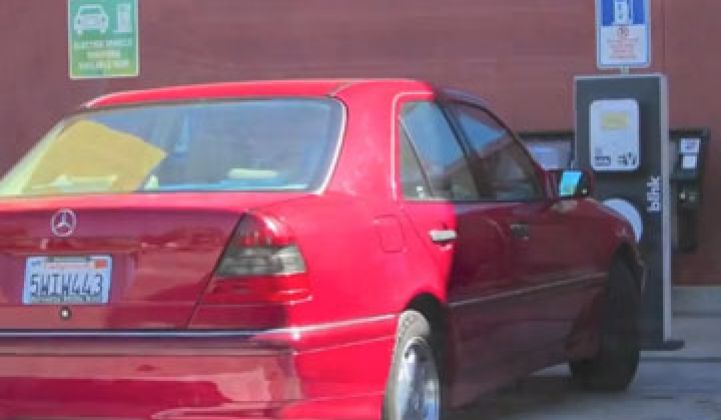There is a chicken-and-egg debate about electric vehicle charging. There needs to be some public charging for those that don’t have garages or at places where EV drivers may spend significant amount of time, such as the workplace or the movie theater.
Of course, all of this charging is only necessary if people buy EVs in significant numbers. For those who fall into the ‘if you build it, they will come’ camp, there is now another potential wrench in the works: keeping the spaces open for people who actually drive electric or plug-in hybrid cars.
Kelly Olsen, former Santa Monica city councilman and electric vehicle advocate, recently put together a video that shows a variety of EV charge spots with non-electric cars -- from Priuses to Porsches -- sitting squarely in the designated spots.
In some scenarios, one could argue that it’s not obvious that the spaces are reserved for EV parking. But most of the spots are well marked, some with large signs that alert people that there is a penalty for parking a gas-guzzler in those spots.
Olsen notes it has been illegal in Santa Monica for internal combustion engine cars to park in EV spaces for a decade, but the law is rarely enforced.
At first glance, it seems like a perfect job for an EV vigilante, snapping pictures of offenders on a smart phone and submitting them to the city as exhibits of easy money they’re missing out on.
Another look, however, shows that for the pockets of the nation that have multiple EVs, this could be a real problem. Already, NRG Energy CEO David Crane is having trouble finding a place to plug in at work.
For those without a garage, like Olsen, who is getting a Volt or Leaf in January, access to charging on the street or at stores is critical. Even for those with a garage, he says the access to at least some charging when it’s needed could be all the difference in the EV experience.
“Getting that extra five to ten miles of charge added could mean the difference between getting home with no problem or frantically and uncomfortably looking for a gas station with an outside Coke machine that can be disconnected to use the wall outlet,” Olsen said.
For people who are less enthusiastic than Olsen, the decision to go all-electric could be swayed the other way if charging spaces are always occupied.
Another potential problem is that for people who pay for access to charging networks, such as ECOtality’s yet-to-be-announced pricing plans, not actually having access because other cars are in the space could be another turnoff.
Of course, technology could help to alleviate the problem. Streetline’s Parker app tells drivers of all kinds if parking spots are available. The system uses sensors that can show drivers on an app what’s open and what’s occupied.
Like speed-detection cameras, sensors and low-cost cameras could also help municipalities enforce the rules without putting more boots on the ground. Theoretically, it is easy enough to send out tickets to violators just by snapping pictures of the cars in the spot.
For commercial locations, careful consideration can also help. Walgreens, which has put in 800 chargers at stores nationwide, said it didn’t want chargers too close to the door, where gas vehicles might steal the convenient spots, but the chargers also can’t be too far from an electrical source, or installing them becomes prohibitively expensive.
The falling price of DC fast-charging could also help, since a car could top off in just a few minutes (if a spot is open), rather than needing to be parked for hours to fill up.
If you think the glass is half full, there is always the possibility that drivers of all stripes will eventually recognize these parking spots as legitimate -- just as most people treat designated handicapped parking spots with respect. Of course, only time will tell.



